Quality Management System Report for Jose's Mexican Restaurant
VerifiedAdded on 2022/12/26
|10
|2666
|25
Report
AI Summary
This report presents a comprehensive analysis of a quality management system (QMS) tailored for Jose's Mexican Restaurant, addressing key clauses of the ISO 9001:2015 standard. The report begins with an introduction outlining the need for a QMS in the restaurant context, emphasizing its role in meeting regulatory requirements and enhancing efficiency. It includes a detailed PEST (Political, Economic, Social, Technological) analysis, both internal and external, to understand the organization's environment and its potential impacts. The report identifies four interested parties (customers, stakeholders, management, and suppliers/partners) and their respective needs and expectations. A quality policy is developed, aligning with ISO requirements and the restaurant's objectives, including improved customer service, compliance with standards, and efficient resource allocation. Furthermore, the report develops a Failure Mode and Effects Analysis (FMEA) for two process steps, detailing potential failures, their consequences, severity, causes, and control actions. Quality objectives are established to align with the quality policy, emphasizing customer satisfaction, and the report concludes with recommendations for ISO certification and continuous improvement, supported by relevant references.
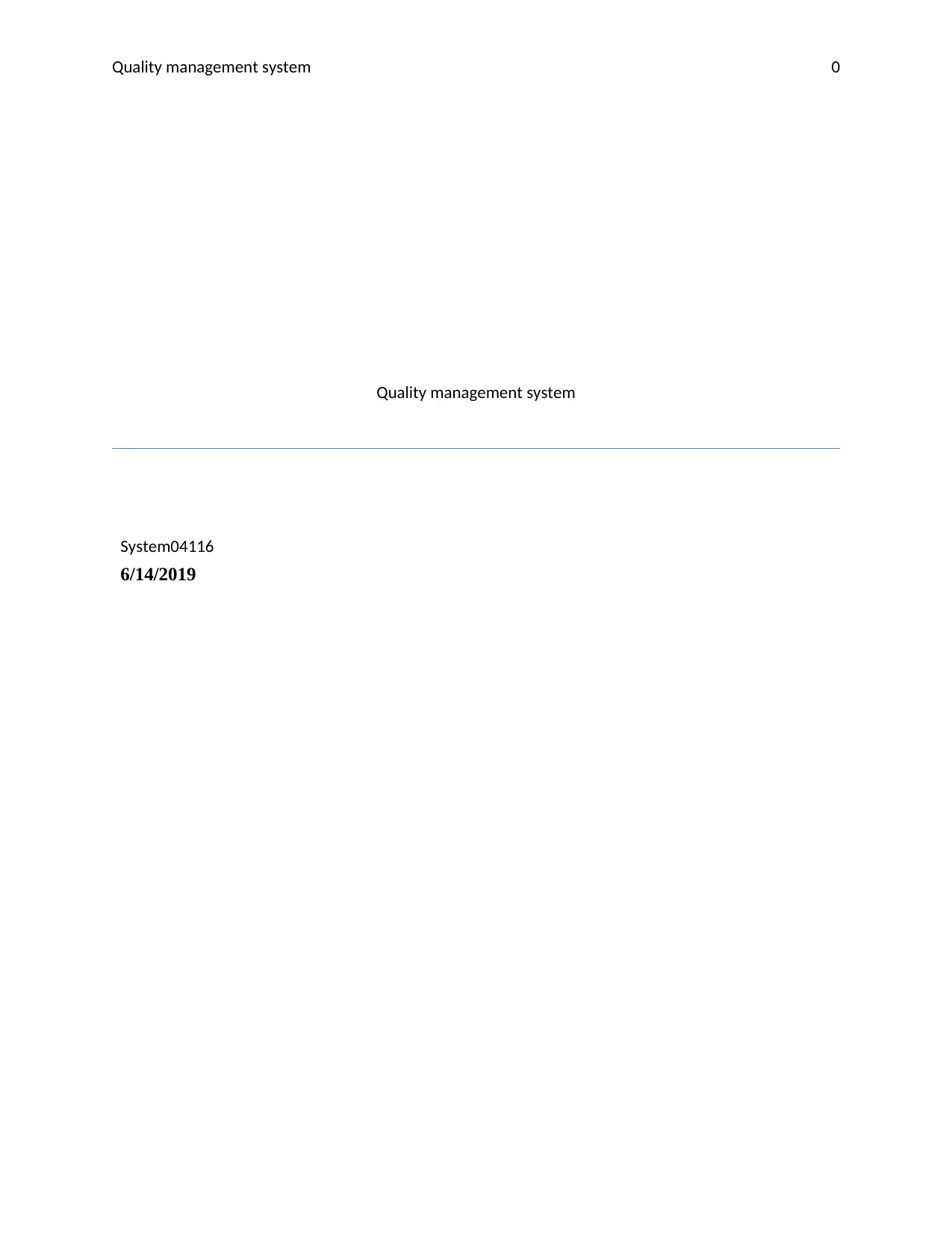
Quality management system 0
Quality management system
System04116
6/14/2019
Quality management system
System04116
6/14/2019
Paraphrase This Document
Need a fresh take? Get an instant paraphrase of this document with our AI Paraphraser
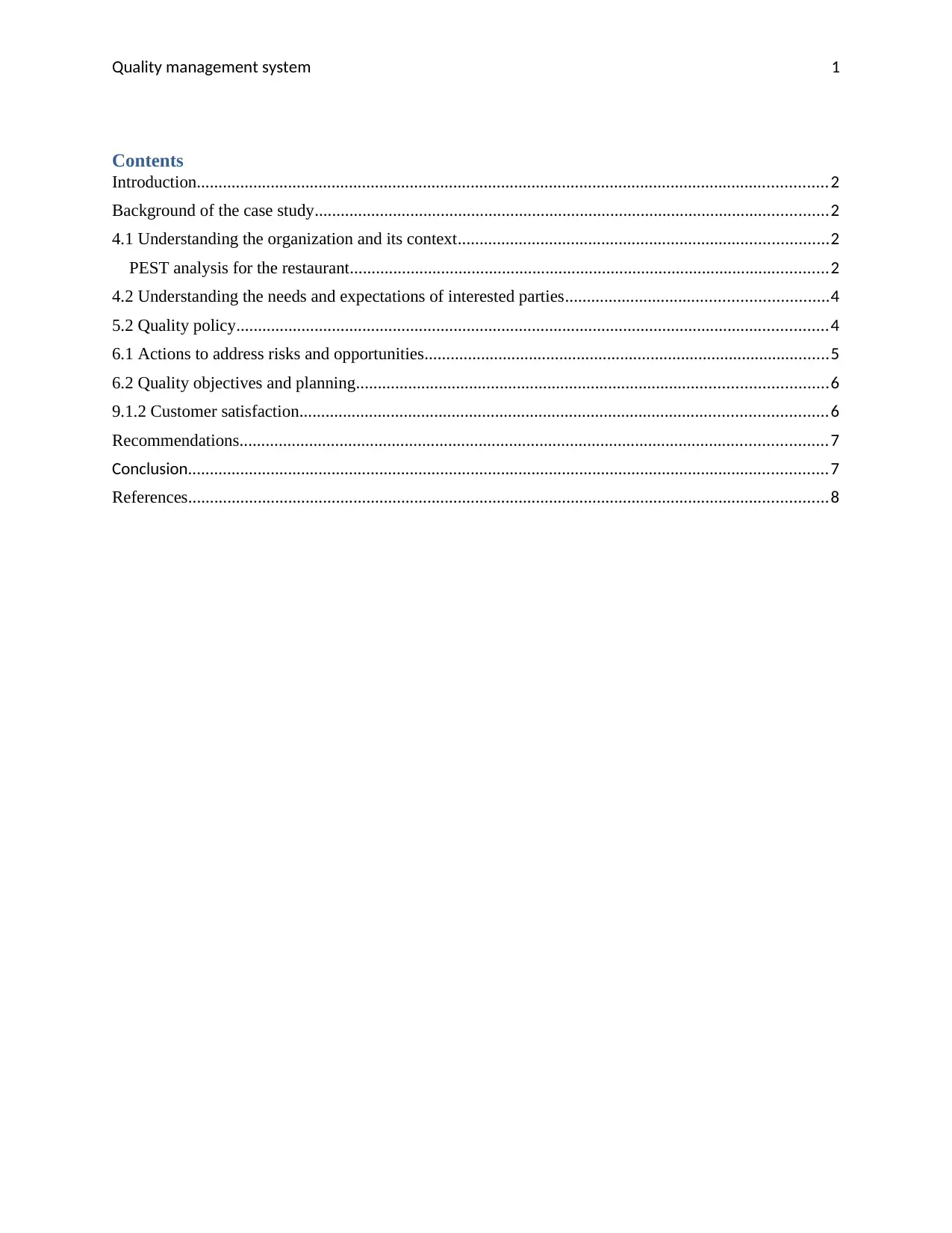
Quality management system 1
Contents
Introduction.................................................................................................................................................2
Background of the case study......................................................................................................................2
4.1 Understanding the organization and its context.....................................................................................2
PEST analysis for the restaurant..............................................................................................................2
4.2 Understanding the needs and expectations of interested parties............................................................4
5.2 Quality policy........................................................................................................................................4
6.1 Actions to address risks and opportunities.............................................................................................5
6.2 Quality objectives and planning............................................................................................................6
9.1.2 Customer satisfaction.........................................................................................................................6
Recommendations.......................................................................................................................................7
Conclusion...................................................................................................................................................7
References...................................................................................................................................................8
Contents
Introduction.................................................................................................................................................2
Background of the case study......................................................................................................................2
4.1 Understanding the organization and its context.....................................................................................2
PEST analysis for the restaurant..............................................................................................................2
4.2 Understanding the needs and expectations of interested parties............................................................4
5.2 Quality policy........................................................................................................................................4
6.1 Actions to address risks and opportunities.............................................................................................5
6.2 Quality objectives and planning............................................................................................................6
9.1.2 Customer satisfaction.........................................................................................................................6
Recommendations.......................................................................................................................................7
Conclusion...................................................................................................................................................7
References...................................................................................................................................................8
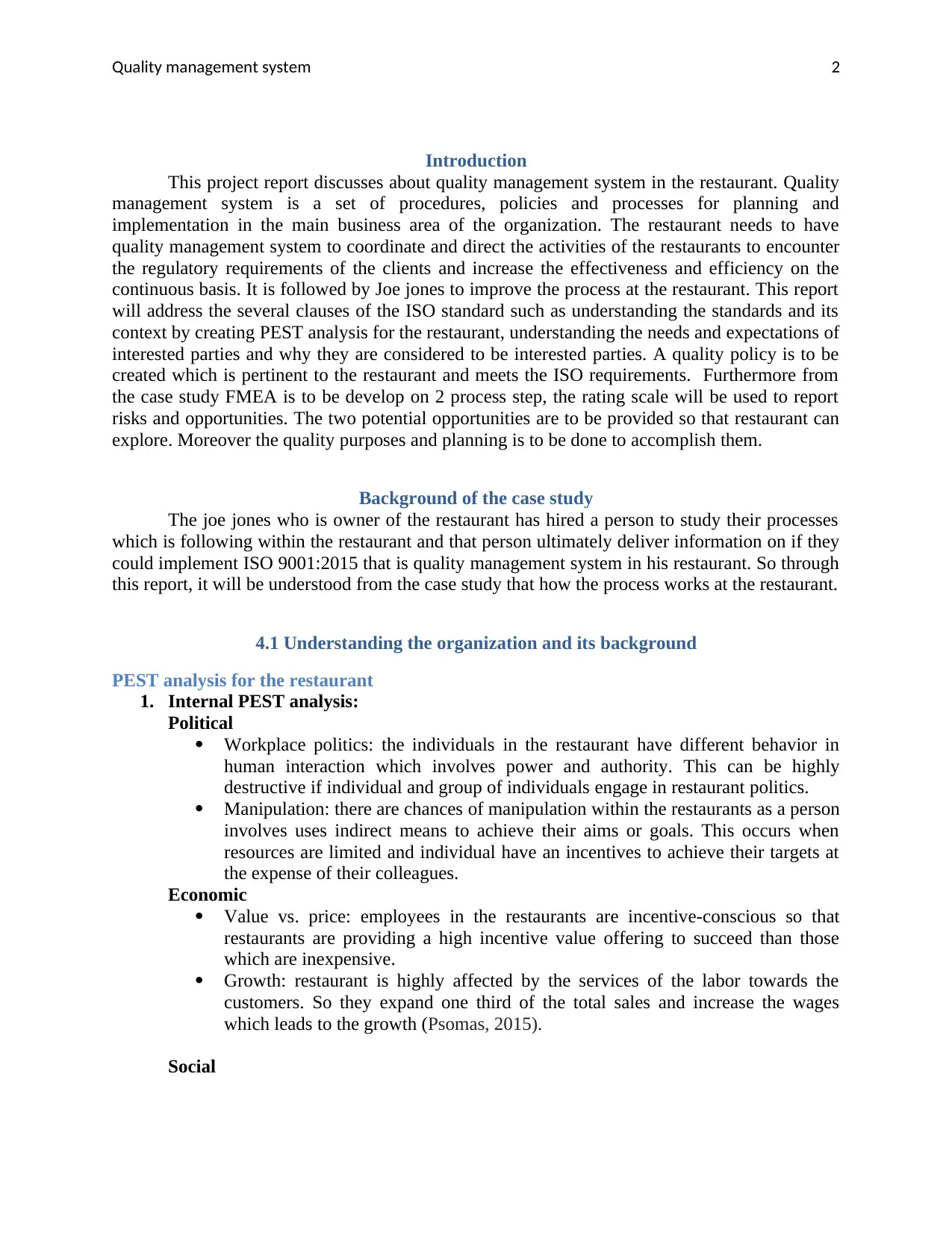
Quality management system 2
Introduction
This project report discusses about quality management system in the restaurant. Quality
management system is a set of procedures, policies and processes for planning and
implementation in the main business area of the organization. The restaurant needs to have
quality management system to coordinate and direct the activities of the restaurants to encounter
the regulatory requirements of the clients and increase the effectiveness and efficiency on the
continuous basis. It is followed by Joe jones to improve the process at the restaurant. This report
will address the several clauses of the ISO standard such as understanding the standards and its
context by creating PEST analysis for the restaurant, understanding the needs and expectations of
interested parties and why they are considered to be interested parties. A quality policy is to be
created which is pertinent to the restaurant and meets the ISO requirements. Furthermore from
the case study FMEA is to be develop on 2 process step, the rating scale will be used to report
risks and opportunities. The two potential opportunities are to be provided so that restaurant can
explore. Moreover the quality purposes and planning is to be done to accomplish them.
Background of the case study
The joe jones who is owner of the restaurant has hired a person to study their processes
which is following within the restaurant and that person ultimately deliver information on if they
could implement ISO 9001:2015 that is quality management system in his restaurant. So through
this report, it will be understood from the case study that how the process works at the restaurant.
4.1 Understanding the organization and its background
PEST analysis for the restaurant
1. Internal PEST analysis:
Political
Workplace politics: the individuals in the restaurant have different behavior in
human interaction which involves power and authority. This can be highly
destructive if individual and group of individuals engage in restaurant politics.
Manipulation: there are chances of manipulation within the restaurants as a person
involves uses indirect means to achieve their aims or goals. This occurs when
resources are limited and individual have an incentives to achieve their targets at
the expense of their colleagues.
Economic
Value vs. price: employees in the restaurants are incentive-conscious so that
restaurants are providing a high incentive value offering to succeed than those
which are inexpensive.
Growth: restaurant is highly affected by the services of the labor towards the
customers. So they expand one third of the total sales and increase the wages
which leads to the growth (Psomas, 2015).
Social
Introduction
This project report discusses about quality management system in the restaurant. Quality
management system is a set of procedures, policies and processes for planning and
implementation in the main business area of the organization. The restaurant needs to have
quality management system to coordinate and direct the activities of the restaurants to encounter
the regulatory requirements of the clients and increase the effectiveness and efficiency on the
continuous basis. It is followed by Joe jones to improve the process at the restaurant. This report
will address the several clauses of the ISO standard such as understanding the standards and its
context by creating PEST analysis for the restaurant, understanding the needs and expectations of
interested parties and why they are considered to be interested parties. A quality policy is to be
created which is pertinent to the restaurant and meets the ISO requirements. Furthermore from
the case study FMEA is to be develop on 2 process step, the rating scale will be used to report
risks and opportunities. The two potential opportunities are to be provided so that restaurant can
explore. Moreover the quality purposes and planning is to be done to accomplish them.
Background of the case study
The joe jones who is owner of the restaurant has hired a person to study their processes
which is following within the restaurant and that person ultimately deliver information on if they
could implement ISO 9001:2015 that is quality management system in his restaurant. So through
this report, it will be understood from the case study that how the process works at the restaurant.
4.1 Understanding the organization and its background
PEST analysis for the restaurant
1. Internal PEST analysis:
Political
Workplace politics: the individuals in the restaurant have different behavior in
human interaction which involves power and authority. This can be highly
destructive if individual and group of individuals engage in restaurant politics.
Manipulation: there are chances of manipulation within the restaurants as a person
involves uses indirect means to achieve their aims or goals. This occurs when
resources are limited and individual have an incentives to achieve their targets at
the expense of their colleagues.
Economic
Value vs. price: employees in the restaurants are incentive-conscious so that
restaurants are providing a high incentive value offering to succeed than those
which are inexpensive.
Growth: restaurant is highly affected by the services of the labor towards the
customers. So they expand one third of the total sales and increase the wages
which leads to the growth (Psomas, 2015).
Social
⊘ This is a preview!⊘
Do you want full access?
Subscribe today to unlock all pages.

Trusted by 1+ million students worldwide
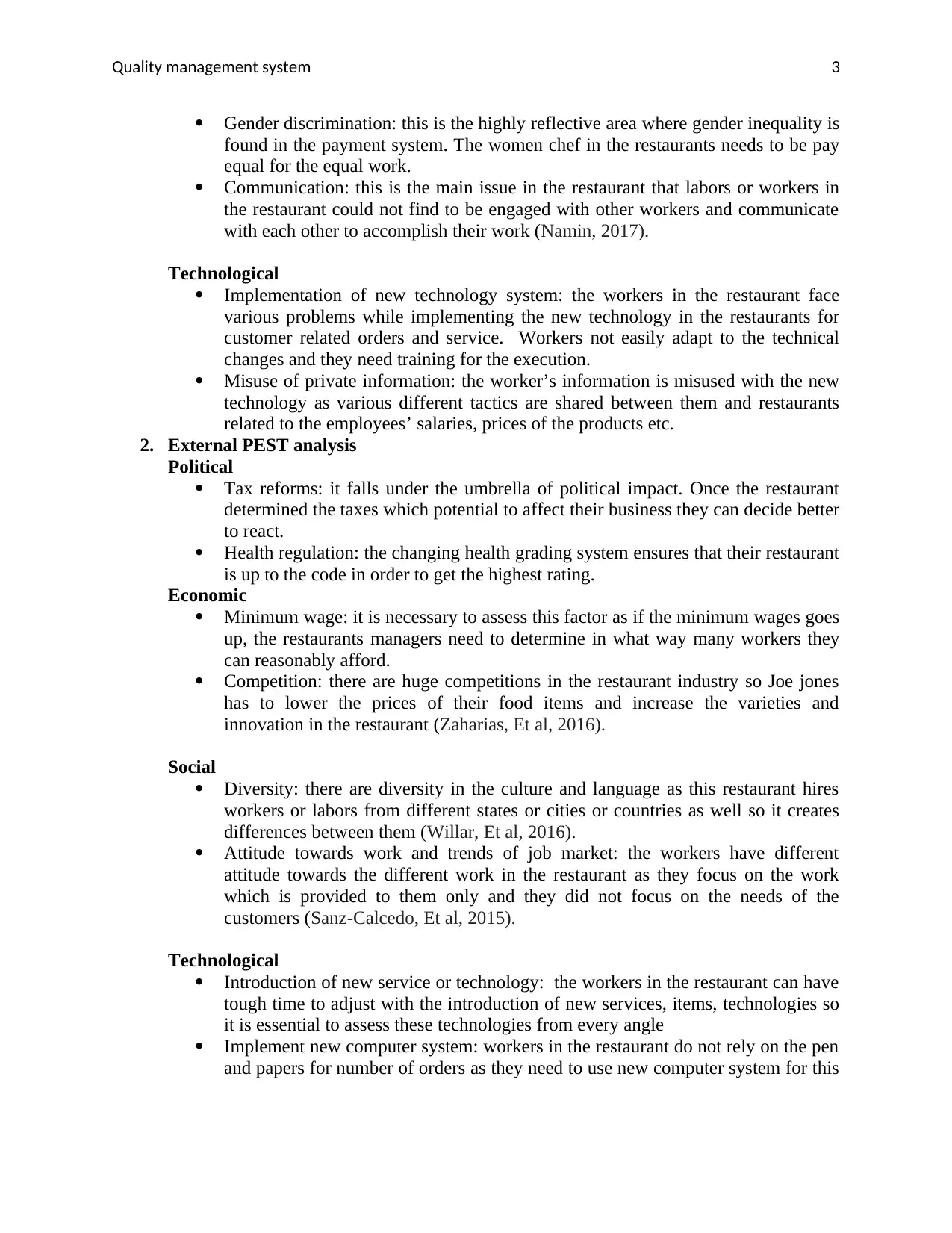
Quality management system 3
Gender discrimination: this is the highly reflective area where gender inequality is
found in the payment system. The women chef in the restaurants needs to be pay
equal for the equal work.
Communication: this is the main issue in the restaurant that labors or workers in
the restaurant could not find to be engaged with other workers and communicate
with each other to accomplish their work (Namin, 2017).
Technological
Implementation of new technology system: the workers in the restaurant face
various problems while implementing the new technology in the restaurants for
customer related orders and service. Workers not easily adapt to the technical
changes and they need training for the execution.
Misuse of private information: the worker’s information is misused with the new
technology as various different tactics are shared between them and restaurants
related to the employees’ salaries, prices of the products etc.
2. External PEST analysis
Political
Tax reforms: it falls under the umbrella of political impact. Once the restaurant
determined the taxes which potential to affect their business they can decide better
to react.
Health regulation: the changing health grading system ensures that their restaurant
is up to the code in order to get the highest rating.
Economic
Minimum wage: it is necessary to assess this factor as if the minimum wages goes
up, the restaurants managers need to determine in what way many workers they
can reasonably afford.
Competition: there are huge competitions in the restaurant industry so Joe jones
has to lower the prices of their food items and increase the varieties and
innovation in the restaurant (Zaharias, Et al, 2016).
Social
Diversity: there are diversity in the culture and language as this restaurant hires
workers or labors from different states or cities or countries as well so it creates
differences between them (Willar, Et al, 2016).
Attitude towards work and trends of job market: the workers have different
attitude towards the different work in the restaurant as they focus on the work
which is provided to them only and they did not focus on the needs of the
customers (Sanz-Calcedo, Et al, 2015).
Technological
Introduction of new service or technology: the workers in the restaurant can have
tough time to adjust with the introduction of new services, items, technologies so
it is essential to assess these technologies from every angle
Implement new computer system: workers in the restaurant do not rely on the pen
and papers for number of orders as they need to use new computer system for this
Gender discrimination: this is the highly reflective area where gender inequality is
found in the payment system. The women chef in the restaurants needs to be pay
equal for the equal work.
Communication: this is the main issue in the restaurant that labors or workers in
the restaurant could not find to be engaged with other workers and communicate
with each other to accomplish their work (Namin, 2017).
Technological
Implementation of new technology system: the workers in the restaurant face
various problems while implementing the new technology in the restaurants for
customer related orders and service. Workers not easily adapt to the technical
changes and they need training for the execution.
Misuse of private information: the worker’s information is misused with the new
technology as various different tactics are shared between them and restaurants
related to the employees’ salaries, prices of the products etc.
2. External PEST analysis
Political
Tax reforms: it falls under the umbrella of political impact. Once the restaurant
determined the taxes which potential to affect their business they can decide better
to react.
Health regulation: the changing health grading system ensures that their restaurant
is up to the code in order to get the highest rating.
Economic
Minimum wage: it is necessary to assess this factor as if the minimum wages goes
up, the restaurants managers need to determine in what way many workers they
can reasonably afford.
Competition: there are huge competitions in the restaurant industry so Joe jones
has to lower the prices of their food items and increase the varieties and
innovation in the restaurant (Zaharias, Et al, 2016).
Social
Diversity: there are diversity in the culture and language as this restaurant hires
workers or labors from different states or cities or countries as well so it creates
differences between them (Willar, Et al, 2016).
Attitude towards work and trends of job market: the workers have different
attitude towards the different work in the restaurant as they focus on the work
which is provided to them only and they did not focus on the needs of the
customers (Sanz-Calcedo, Et al, 2015).
Technological
Introduction of new service or technology: the workers in the restaurant can have
tough time to adjust with the introduction of new services, items, technologies so
it is essential to assess these technologies from every angle
Implement new computer system: workers in the restaurant do not rely on the pen
and papers for number of orders as they need to use new computer system for this
Paraphrase This Document
Need a fresh take? Get an instant paraphrase of this document with our AI Paraphraser
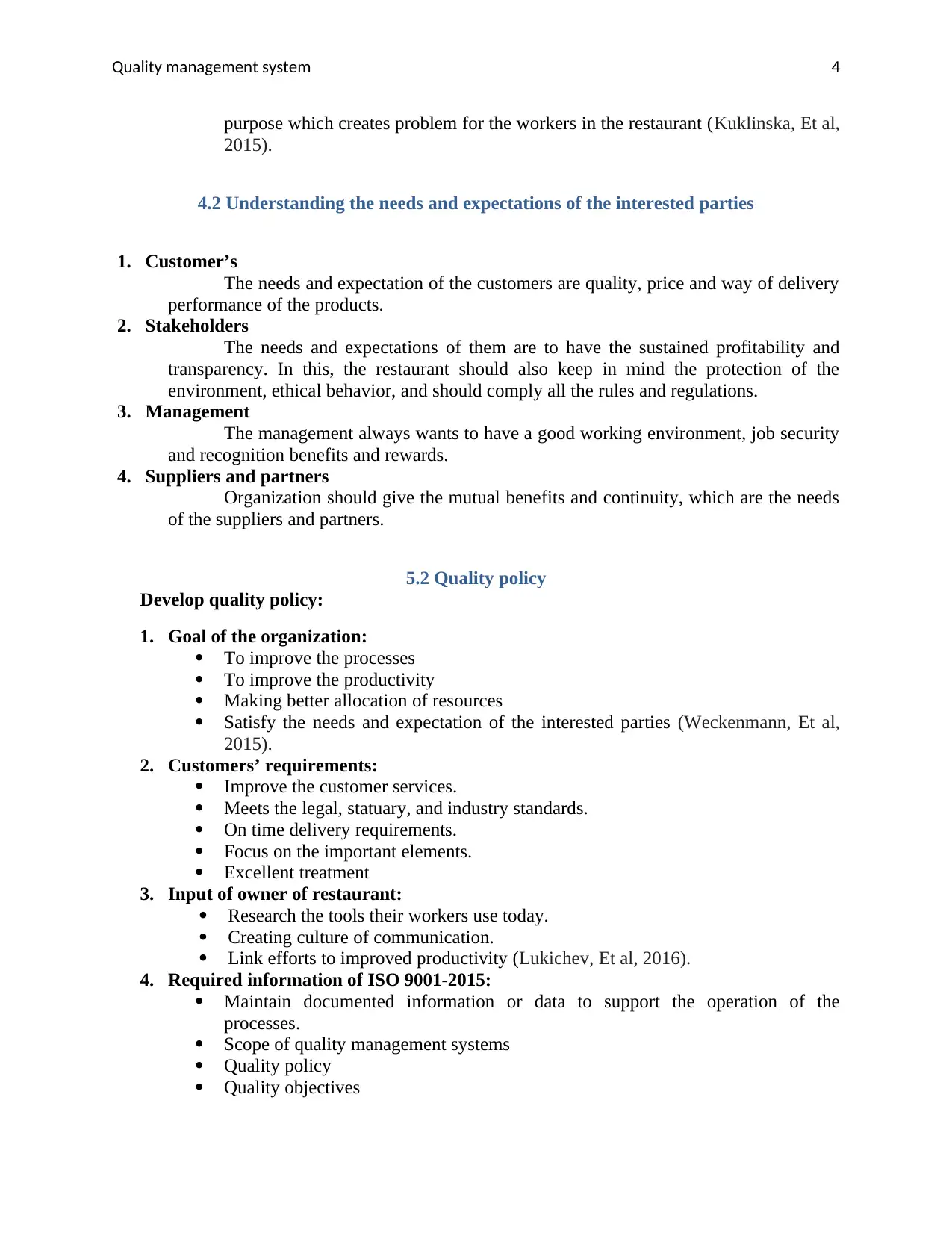
Quality management system 4
purpose which creates problem for the workers in the restaurant (Kuklinska, Et al,
2015).
4.2 Understanding the needs and expectations of the interested parties
1. Customer’s
The needs and expectation of the customers are quality, price and way of delivery
performance of the products.
2. Stakeholders
The needs and expectations of them are to have the sustained profitability and
transparency. In this, the restaurant should also keep in mind the protection of the
environment, ethical behavior, and should comply all the rules and regulations.
3. Management
The management always wants to have a good working environment, job security
and recognition benefits and rewards.
4. Suppliers and partners
Organization should give the mutual benefits and continuity, which are the needs
of the suppliers and partners.
5.2 Quality policy
Develop quality policy:
1. Goal of the organization:
To improve the processes
To improve the productivity
Making better allocation of resources
Satisfy the needs and expectation of the interested parties (Weckenmann, Et al,
2015).
2. Customers’ requirements:
Improve the customer services.
Meets the legal, statuary, and industry standards.
On time delivery requirements.
Focus on the important elements.
Excellent treatment
3. Input of owner of restaurant:
Research the tools their workers use today.
Creating culture of communication.
Link efforts to improved productivity (Lukichev, Et al, 2016).
4. Required information of ISO 9001-2015:
Maintain documented information or data to support the operation of the
processes.
Scope of quality management systems
Quality policy
Quality objectives
purpose which creates problem for the workers in the restaurant (Kuklinska, Et al,
2015).
4.2 Understanding the needs and expectations of the interested parties
1. Customer’s
The needs and expectation of the customers are quality, price and way of delivery
performance of the products.
2. Stakeholders
The needs and expectations of them are to have the sustained profitability and
transparency. In this, the restaurant should also keep in mind the protection of the
environment, ethical behavior, and should comply all the rules and regulations.
3. Management
The management always wants to have a good working environment, job security
and recognition benefits and rewards.
4. Suppliers and partners
Organization should give the mutual benefits and continuity, which are the needs
of the suppliers and partners.
5.2 Quality policy
Develop quality policy:
1. Goal of the organization:
To improve the processes
To improve the productivity
Making better allocation of resources
Satisfy the needs and expectation of the interested parties (Weckenmann, Et al,
2015).
2. Customers’ requirements:
Improve the customer services.
Meets the legal, statuary, and industry standards.
On time delivery requirements.
Focus on the important elements.
Excellent treatment
3. Input of owner of restaurant:
Research the tools their workers use today.
Creating culture of communication.
Link efforts to improved productivity (Lukichev, Et al, 2016).
4. Required information of ISO 9001-2015:
Maintain documented information or data to support the operation of the
processes.
Scope of quality management systems
Quality policy
Quality objectives
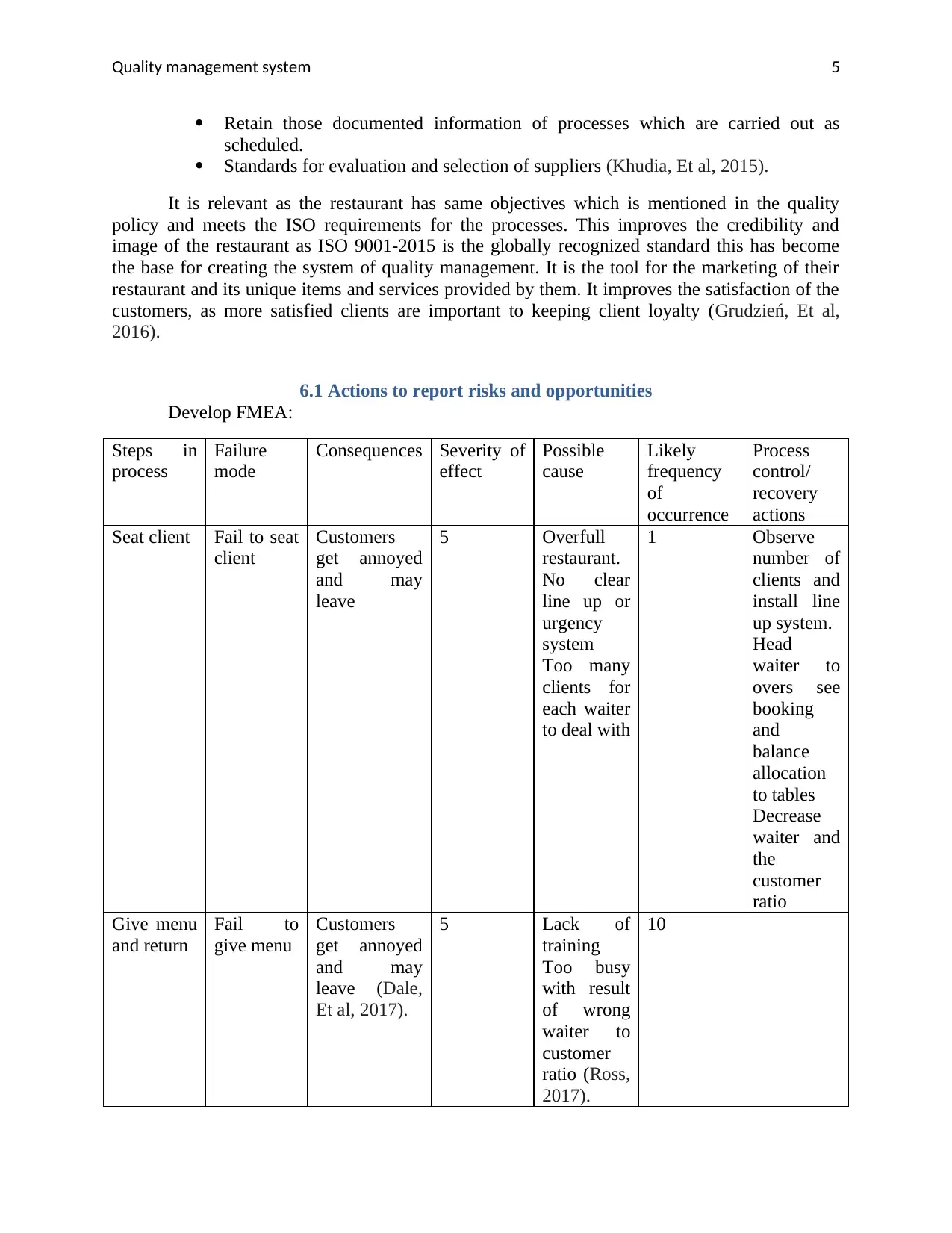
Quality management system 5
Retain those documented information of processes which are carried out as
scheduled.
Standards for evaluation and selection of suppliers (Khudia, Et al, 2015).
It is relevant as the restaurant has same objectives which is mentioned in the quality
policy and meets the ISO requirements for the processes. This improves the credibility and
image of the restaurant as ISO 9001-2015 is the globally recognized standard this has become
the base for creating the system of quality management. It is the tool for the marketing of their
restaurant and its unique items and services provided by them. It improves the satisfaction of the
customers, as more satisfied clients are important to keeping client loyalty (Grudzień, Et al,
2016).
6.1 Actions to report risks and opportunities
Develop FMEA:
Steps in
process
Failure
mode
Consequences Severity of
effect
Possible
cause
Likely
frequency
of
occurrence
Process
control/
recovery
actions
Seat client Fail to seat
client
Customers
get annoyed
and may
leave
5 Overfull
restaurant.
No clear
line up or
urgency
system
Too many
clients for
each waiter
to deal with
1 Observe
number of
clients and
install line
up system.
Head
waiter to
overs see
booking
and
balance
allocation
to tables
Decrease
waiter and
the
customer
ratio
Give menu
and return
Fail to
give menu
Customers
get annoyed
and may
leave (Dale,
Et al, 2017).
5 Lack of
training
Too busy
with result
of wrong
waiter to
customer
ratio (Ross,
2017).
10
Retain those documented information of processes which are carried out as
scheduled.
Standards for evaluation and selection of suppliers (Khudia, Et al, 2015).
It is relevant as the restaurant has same objectives which is mentioned in the quality
policy and meets the ISO requirements for the processes. This improves the credibility and
image of the restaurant as ISO 9001-2015 is the globally recognized standard this has become
the base for creating the system of quality management. It is the tool for the marketing of their
restaurant and its unique items and services provided by them. It improves the satisfaction of the
customers, as more satisfied clients are important to keeping client loyalty (Grudzień, Et al,
2016).
6.1 Actions to report risks and opportunities
Develop FMEA:
Steps in
process
Failure
mode
Consequences Severity of
effect
Possible
cause
Likely
frequency
of
occurrence
Process
control/
recovery
actions
Seat client Fail to seat
client
Customers
get annoyed
and may
leave
5 Overfull
restaurant.
No clear
line up or
urgency
system
Too many
clients for
each waiter
to deal with
1 Observe
number of
clients and
install line
up system.
Head
waiter to
overs see
booking
and
balance
allocation
to tables
Decrease
waiter and
the
customer
ratio
Give menu
and return
Fail to
give menu
Customers
get annoyed
and may
leave (Dale,
Et al, 2017).
5 Lack of
training
Too busy
with result
of wrong
waiter to
customer
ratio (Ross,
2017).
10
⊘ This is a preview!⊘
Do you want full access?
Subscribe today to unlock all pages.

Trusted by 1+ million students worldwide

Quality management system 6
6.2 Quality objectives and planning
The quality objective will be constant with the quality policy should always be
quantifiable, objective should take care of the quality requirement, always be frame to comply
with the satisfaction of customers. Objectives should be monitored and be communicated.
The restaurants should maintain the recognized information on the quality goals.
And to accomplish the objective the organizational will determine, what will be one,
what resources are needed, who will be liable. The quality plans should specify the process,
procedures and the responsible person who will meet the requirement.
9.1.2 Customer satisfaction
From the survey it is suggested that they should first tackle the issue of served in a
reasonable time them tackle another issues such as promptly sitting of customers, satisfactory
waiter, enjoyable food, experience of dining which worth the cost as it mandatory that restaurant
has to serve their customer with respect and satisfy all the needs and expectations. Use the right
terms and show immediate action and way out so that customers do not feel that they are served
in a reasonable time and serve their order in a minimum time which gives positive impression on
them about the restaurant (Gouiaa, Et al, 2018).
6.2 Quality objectives and planning
The quality objective will be constant with the quality policy should always be
quantifiable, objective should take care of the quality requirement, always be frame to comply
with the satisfaction of customers. Objectives should be monitored and be communicated.
The restaurants should maintain the recognized information on the quality goals.
And to accomplish the objective the organizational will determine, what will be one,
what resources are needed, who will be liable. The quality plans should specify the process,
procedures and the responsible person who will meet the requirement.
9.1.2 Customer satisfaction
From the survey it is suggested that they should first tackle the issue of served in a
reasonable time them tackle another issues such as promptly sitting of customers, satisfactory
waiter, enjoyable food, experience of dining which worth the cost as it mandatory that restaurant
has to serve their customer with respect and satisfy all the needs and expectations. Use the right
terms and show immediate action and way out so that customers do not feel that they are served
in a reasonable time and serve their order in a minimum time which gives positive impression on
them about the restaurant (Gouiaa, Et al, 2018).
Paraphrase This Document
Need a fresh take? Get an instant paraphrase of this document with our AI Paraphraser
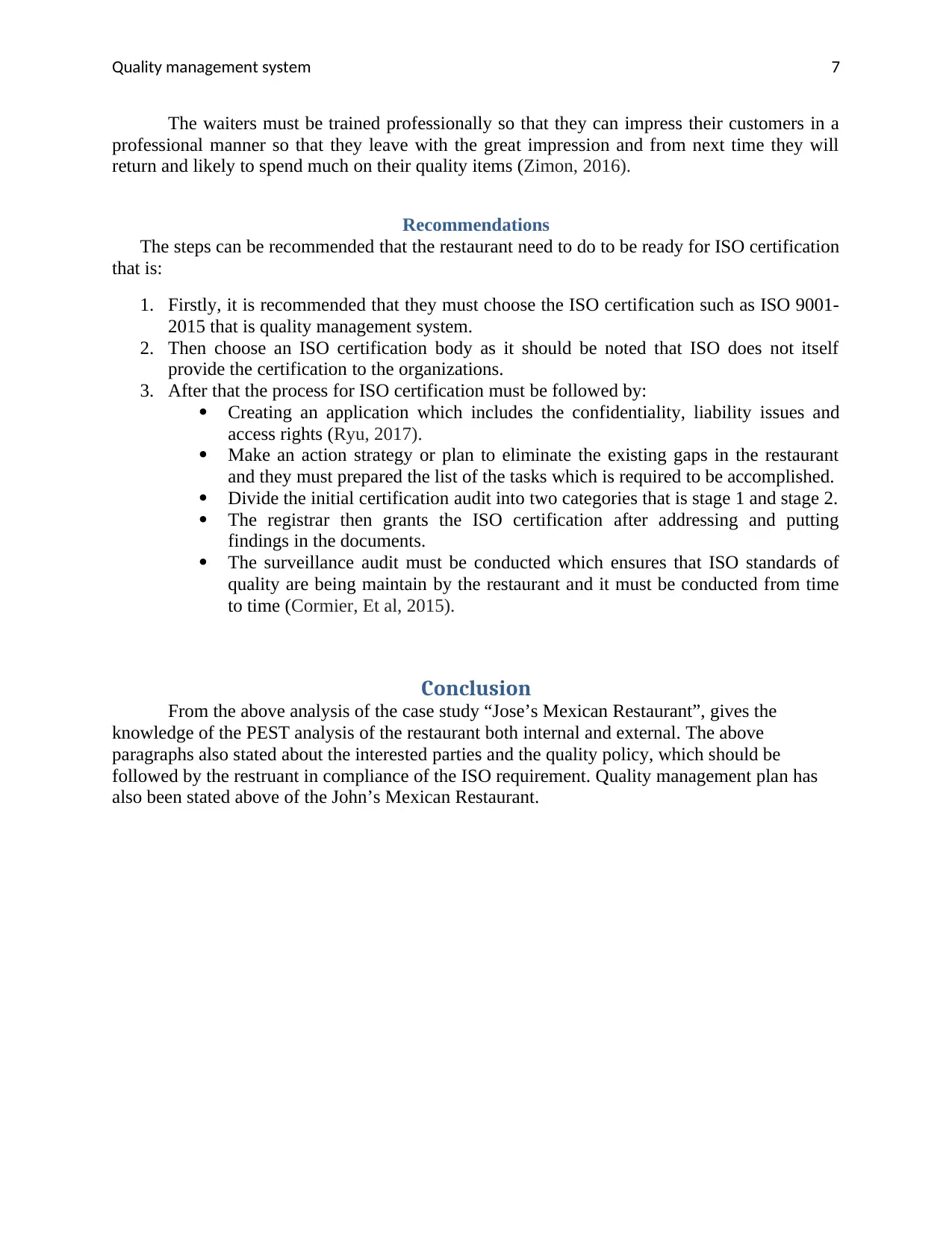
Quality management system 7
The waiters must be trained professionally so that they can impress their customers in a
professional manner so that they leave with the great impression and from next time they will
return and likely to spend much on their quality items (Zimon, 2016).
Recommendations
The steps can be recommended that the restaurant need to do to be ready for ISO certification
that is:
1. Firstly, it is recommended that they must choose the ISO certification such as ISO 9001-
2015 that is quality management system.
2. Then choose an ISO certification body as it should be noted that ISO does not itself
provide the certification to the organizations.
3. After that the process for ISO certification must be followed by:
Creating an application which includes the confidentiality, liability issues and
access rights (Ryu, 2017).
Make an action strategy or plan to eliminate the existing gaps in the restaurant
and they must prepared the list of the tasks which is required to be accomplished.
Divide the initial certification audit into two categories that is stage 1 and stage 2.
The registrar then grants the ISO certification after addressing and putting
findings in the documents.
The surveillance audit must be conducted which ensures that ISO standards of
quality are being maintain by the restaurant and it must be conducted from time
to time (Cormier, Et al, 2015).
Conclusion
From the above analysis of the case study “Jose’s Mexican Restaurant”, gives the
knowledge of the PEST analysis of the restaurant both internal and external. The above
paragraphs also stated about the interested parties and the quality policy, which should be
followed by the restruant in compliance of the ISO requirement. Quality management plan has
also been stated above of the John’s Mexican Restaurant.
The waiters must be trained professionally so that they can impress their customers in a
professional manner so that they leave with the great impression and from next time they will
return and likely to spend much on their quality items (Zimon, 2016).
Recommendations
The steps can be recommended that the restaurant need to do to be ready for ISO certification
that is:
1. Firstly, it is recommended that they must choose the ISO certification such as ISO 9001-
2015 that is quality management system.
2. Then choose an ISO certification body as it should be noted that ISO does not itself
provide the certification to the organizations.
3. After that the process for ISO certification must be followed by:
Creating an application which includes the confidentiality, liability issues and
access rights (Ryu, 2017).
Make an action strategy or plan to eliminate the existing gaps in the restaurant
and they must prepared the list of the tasks which is required to be accomplished.
Divide the initial certification audit into two categories that is stage 1 and stage 2.
The registrar then grants the ISO certification after addressing and putting
findings in the documents.
The surveillance audit must be conducted which ensures that ISO standards of
quality are being maintain by the restaurant and it must be conducted from time
to time (Cormier, Et al, 2015).
Conclusion
From the above analysis of the case study “Jose’s Mexican Restaurant”, gives the
knowledge of the PEST analysis of the restaurant both internal and external. The above
paragraphs also stated about the interested parties and the quality policy, which should be
followed by the restruant in compliance of the ISO requirement. Quality management plan has
also been stated above of the John’s Mexican Restaurant.
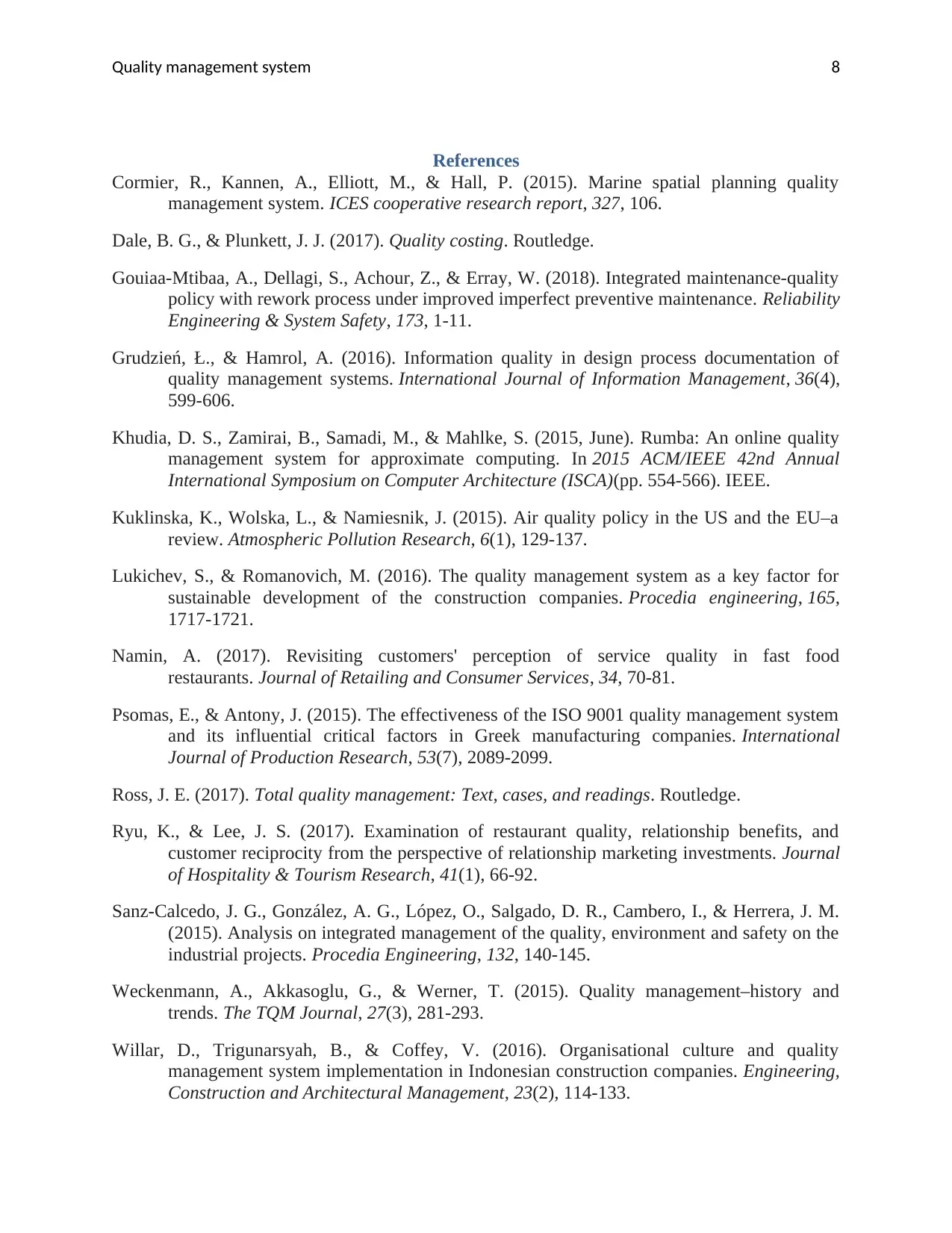
Quality management system 8
References
Cormier, R., Kannen, A., Elliott, M., & Hall, P. (2015). Marine spatial planning quality
management system. ICES cooperative research report, 327, 106.
Dale, B. G., & Plunkett, J. J. (2017). Quality costing. Routledge.
Gouiaa-Mtibaa, A., Dellagi, S., Achour, Z., & Erray, W. (2018). Integrated maintenance-quality
policy with rework process under improved imperfect preventive maintenance. Reliability
Engineering & System Safety, 173, 1-11.
Grudzień, Ł., & Hamrol, A. (2016). Information quality in design process documentation of
quality management systems. International Journal of Information Management, 36(4),
599-606.
Khudia, D. S., Zamirai, B., Samadi, M., & Mahlke, S. (2015, June). Rumba: An online quality
management system for approximate computing. In 2015 ACM/IEEE 42nd Annual
International Symposium on Computer Architecture (ISCA)(pp. 554-566). IEEE.
Kuklinska, K., Wolska, L., & Namiesnik, J. (2015). Air quality policy in the US and the EU–a
review. Atmospheric Pollution Research, 6(1), 129-137.
Lukichev, S., & Romanovich, M. (2016). The quality management system as a key factor for
sustainable development of the construction companies. Procedia engineering, 165,
1717-1721.
Namin, A. (2017). Revisiting customers' perception of service quality in fast food
restaurants. Journal of Retailing and Consumer Services, 34, 70-81.
Psomas, E., & Antony, J. (2015). The effectiveness of the ISO 9001 quality management system
and its influential critical factors in Greek manufacturing companies. International
Journal of Production Research, 53(7), 2089-2099.
Ross, J. E. (2017). Total quality management: Text, cases, and readings. Routledge.
Ryu, K., & Lee, J. S. (2017). Examination of restaurant quality, relationship benefits, and
customer reciprocity from the perspective of relationship marketing investments. Journal
of Hospitality & Tourism Research, 41(1), 66-92.
Sanz-Calcedo, J. G., González, A. G., López, O., Salgado, D. R., Cambero, I., & Herrera, J. M.
(2015). Analysis on integrated management of the quality, environment and safety on the
industrial projects. Procedia Engineering, 132, 140-145.
Weckenmann, A., Akkasoglu, G., & Werner, T. (2015). Quality management–history and
trends. The TQM Journal, 27(3), 281-293.
Willar, D., Trigunarsyah, B., & Coffey, V. (2016). Organisational culture and quality
management system implementation in Indonesian construction companies. Engineering,
Construction and Architectural Management, 23(2), 114-133.
References
Cormier, R., Kannen, A., Elliott, M., & Hall, P. (2015). Marine spatial planning quality
management system. ICES cooperative research report, 327, 106.
Dale, B. G., & Plunkett, J. J. (2017). Quality costing. Routledge.
Gouiaa-Mtibaa, A., Dellagi, S., Achour, Z., & Erray, W. (2018). Integrated maintenance-quality
policy with rework process under improved imperfect preventive maintenance. Reliability
Engineering & System Safety, 173, 1-11.
Grudzień, Ł., & Hamrol, A. (2016). Information quality in design process documentation of
quality management systems. International Journal of Information Management, 36(4),
599-606.
Khudia, D. S., Zamirai, B., Samadi, M., & Mahlke, S. (2015, June). Rumba: An online quality
management system for approximate computing. In 2015 ACM/IEEE 42nd Annual
International Symposium on Computer Architecture (ISCA)(pp. 554-566). IEEE.
Kuklinska, K., Wolska, L., & Namiesnik, J. (2015). Air quality policy in the US and the EU–a
review. Atmospheric Pollution Research, 6(1), 129-137.
Lukichev, S., & Romanovich, M. (2016). The quality management system as a key factor for
sustainable development of the construction companies. Procedia engineering, 165,
1717-1721.
Namin, A. (2017). Revisiting customers' perception of service quality in fast food
restaurants. Journal of Retailing and Consumer Services, 34, 70-81.
Psomas, E., & Antony, J. (2015). The effectiveness of the ISO 9001 quality management system
and its influential critical factors in Greek manufacturing companies. International
Journal of Production Research, 53(7), 2089-2099.
Ross, J. E. (2017). Total quality management: Text, cases, and readings. Routledge.
Ryu, K., & Lee, J. S. (2017). Examination of restaurant quality, relationship benefits, and
customer reciprocity from the perspective of relationship marketing investments. Journal
of Hospitality & Tourism Research, 41(1), 66-92.
Sanz-Calcedo, J. G., González, A. G., López, O., Salgado, D. R., Cambero, I., & Herrera, J. M.
(2015). Analysis on integrated management of the quality, environment and safety on the
industrial projects. Procedia Engineering, 132, 140-145.
Weckenmann, A., Akkasoglu, G., & Werner, T. (2015). Quality management–history and
trends. The TQM Journal, 27(3), 281-293.
Willar, D., Trigunarsyah, B., & Coffey, V. (2016). Organisational culture and quality
management system implementation in Indonesian construction companies. Engineering,
Construction and Architectural Management, 23(2), 114-133.
⊘ This is a preview!⊘
Do you want full access?
Subscribe today to unlock all pages.

Trusted by 1+ million students worldwide
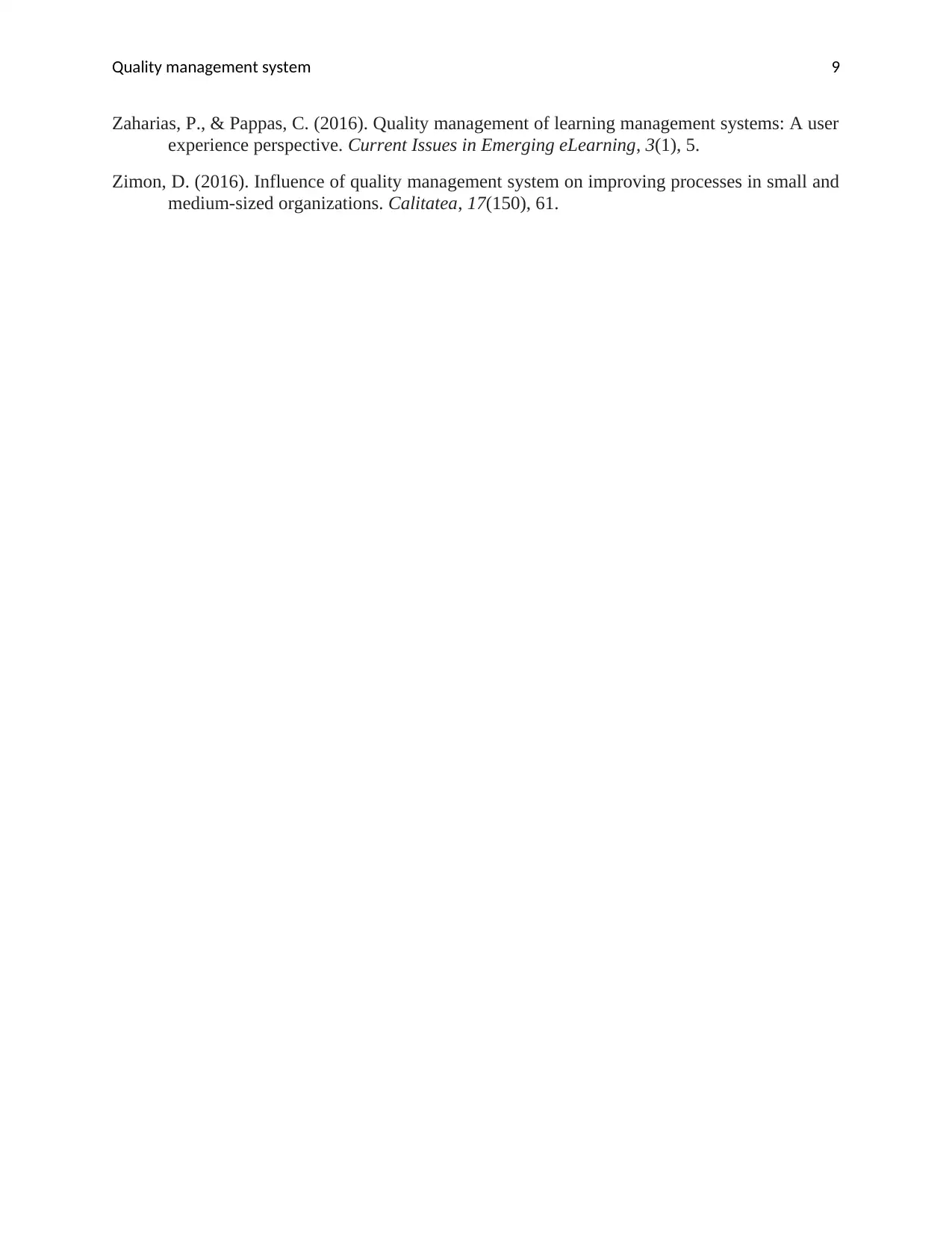
Quality management system 9
Zaharias, P., & Pappas, C. (2016). Quality management of learning management systems: A user
experience perspective. Current Issues in Emerging eLearning, 3(1), 5.
Zimon, D. (2016). Influence of quality management system on improving processes in small and
medium-sized organizations. Calitatea, 17(150), 61.
Zaharias, P., & Pappas, C. (2016). Quality management of learning management systems: A user
experience perspective. Current Issues in Emerging eLearning, 3(1), 5.
Zimon, D. (2016). Influence of quality management system on improving processes in small and
medium-sized organizations. Calitatea, 17(150), 61.
1 out of 10
Related Documents
Your All-in-One AI-Powered Toolkit for Academic Success.
+13062052269
info@desklib.com
Available 24*7 on WhatsApp / Email
![[object Object]](/_next/static/media/star-bottom.7253800d.svg)
Unlock your academic potential
Copyright © 2020–2025 A2Z Services. All Rights Reserved. Developed and managed by ZUCOL.





